Banhu
The banhu is a two-string stick-fiddle from China, primarily used in Northern Chinese regional operas due to its high piercing sound. The banhu is also used for narrative singing, and is now is also used in Chinese traditional instrument orchestras. it has a shallow coconut shell resonator, open on the back with a wooden top. Two large pegs enter the neck on one side only and the neck pierces the body to end in a large wooden block that sits on the player's lap. The metal stings travel over a large ivory or plastic raised nut and then over a small movable bridge, to attach to the bottom block. The bow is separate from the strings, is thicker than other Chinese (huqin) fiddles, and is held to tension by the player’s hand.
Deyurey
Known by a number of names this is a one string fiddle from the Philippines, that has not been ffully identified. This version is made from a coconut shell with a very wide bridge. Other versions have smaller bridgees and wooden or bamboo resonators This version came with a metal streng and was found in Sarawak, Malaysia.

Dilruba
The dilruba is a bowed rebab of North India and Pakistan. It is used for both religious music and popular music, and is very popular in Sikh music. Similar in basic construction with the esraj of Bengal, the wooden neck is hollow with moveable hooped frets that allow for bending the strings. The wooden waisted body is covered in goatskin. There are four mainstrings and twelve or more sympatheic strings, all of metal. The sympathic strings combined with the skin top result in a beautiful resonant, almost hollow sound that makes it popular as an instrument of virtuosity as well as to accompany singing. The sound is distinct yet similar to the Indian sarangi.

Endingidi
The Endingidi is a one-string spike-fiddle from Uganda, created in 1906-7 by Eriya Kafero. The tubular resonator has an animal skin top. Usually a small piece of pitch is attached at the bottom edge of the skin to act as a bridge. The neck pierces the body and a single peg is inserted from the back, usually decorated with goat hair. The strings are sisal, gut or now metal. The small bow uses sisal in place of hair.
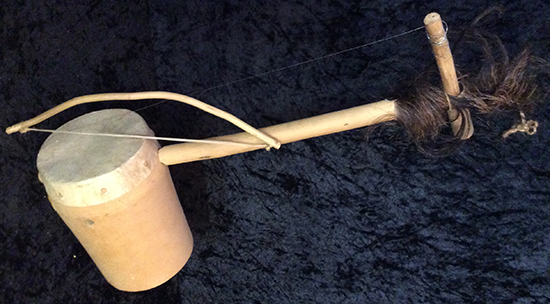
Erhu
The erhu is the most common stick-fiddle of China. The name translates roughly to the words "two" and "barbarian", as it came to China approximately a thousand years ago from the tribal peoples of the north. The modern erhu has two metal strings that are very close to each other, and a thin wooden neck and a round tubular, hexagonal, or octagonal body covered with a python skin top. The horsehair bowstrings are placed between the two strings of the instrument. The erhu has a sweet round tone and is capable of a high degree of virtuosity. It is used as a solo instrument, in numerous ensembles, and in the traditional instrument orchestra.

Goge
The goge is a West African one-string stick-fiddle found in a variety of shapes and sizes and known by a number of names. The most common form is known as goge by the Hausa and Yoruba in Nigeria; and the Songhay, Djerma, Mauri, and Hausa in Niger. In Ghana the Mamprusi-Dagomba call it a gonje, and in Benin it can be referred to as a godie. Typically, goge are made from a lizard skin covered half gourd, pierced by a thin neck and a horsehair string that passes over a small bridge placed close to the edge of the gourd. Bowed with a small horsehair bow, the goge has a very distinctive sound that makes use of a multiphonic voice. Played by both men and women with great virtuosity, the goge is used in small ensembles and to accompany singing.
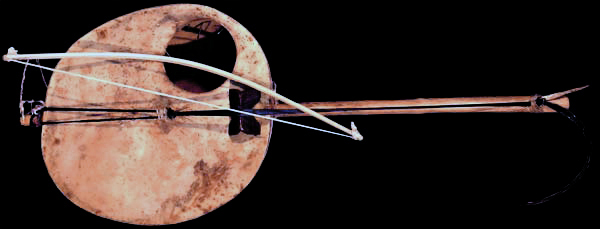
Gusle
The gusle is a one-string fiddle found in Serbia and surrounding regions. It has a single peg at the rear of the neck, a horsehair string, a kidskin (young goat) top, and a movable bridge. Traditional instruments usually featured a head carved figure of goat, snake, or bird, however now many instruments are now made for the tourist market and extremely elaborate and arguably gaudy heads have become common. Traditionally the gusle was used to accompany voice in the performance of epic poems.

Haegum
The haegum is a two-string stick-fiddle of Korea. It is one of a very few stick-fiddles that have the pegs inserted from the front. The neck penetrates the wooden resonator, and there is a movable bridge. Modern versions are made with a wooden top, although there are still some with a skin top. Like the Chinese erhu, the bowstring goes between the strings. Fretting the haegum is unique, rather than only lightly touching the strings as is normal with stick fiddles, the fundamental technique is to pull the strings towards the neck to achieve pitch with the the first three fingers of the left hand, and then higher pitches are reached through tension or by adding touches with the little finger. This makes the haegum one of the most challenging stick-fiddles to play in tune, and yet this is achieved with great accuracy by good players. This method of fretting makes the deep vibrato common in Korean traditional music easily and efficiently performed. The haegum is used in a number of court and folk music ensembles. It is thought to have come to Korea from Mongolia.

Idonongo
The indonongo is a one-string stick-fiddle of Burundi and is related to the Bale people's taratibu in Rwanda and the Democratic Republic of Congo. Its origin is from the endingidi of Uganda. The resonator is made from ox horn, and both the string and bowstring are made from ox tendon. The bridge is not fixed. The indonongo is used to accompany singing.
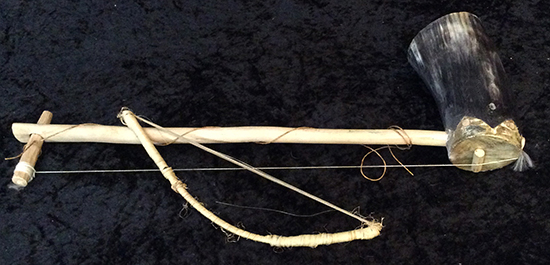
Izeze
The izeze is a four to fourteen string stick-zither of the Wagogo people, of Tanzania, that comes in various sizes. The small 4 string izeze is usually bowed, and the larger instruments are bowed and/or plucked. The gourd resonator is covered with goat, reptile, or snakeskin and is pierced by the neck. The tuning pegs are inserted into the rear of the neck. Traditionally the strings were fibre or sinew but now are metal. The strings run over the movable bridge, with at least one running through the bridge as an open string. The Zawose family of performers are maintaining the tradition of the izeze with performances around the world. Their patriarch Hukwe Zawose is said to have invented the izeze from the one-string zeze, however it is more likely that he popularized it, as he had recorded with Peter Gabriel and other international artists. The izeze is both an ensemble and a solo instrument and usually accompanies vocal music.The instrument pictured was presented to Randy Raine-Reusch as a personal gift from the Zawose family. See an interesting article on the izezse here.
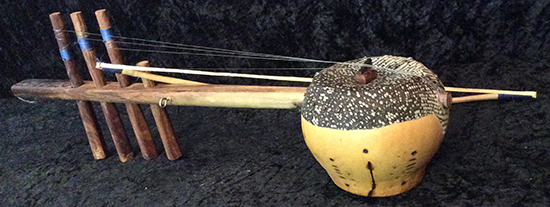
Kingri
The kingri is a one-string stick-fiddle from central India. The body is single slat of bamboo, with a tuning peg mounted from the rear. The body pierces through a small unglazed clay resonator covered on top with goatskin. Traditionally the string was of horsehair but often now has been replaced with a metal string. The movable bridge is a small piece of bamboo or rattan. Traditionally the kingri would be played for religious and social ceremonies. It is often associated with itinerant musicians, and it sometimes is referred to as a "gypsy fiddle." The kingri has seen a resurgence as a tourist item.

Koni
The koni is a very unique form of stick-fiddle found only in Vietnam. It originated as a bamboo one-string fiddle of the Jarai people who live in the south central highlands of Vietnam, and played in a half kneeling position, with the base of the instrument held to the ground between the toes of the left foot. The modern koni now has two metal strings and is held gripped between the player's legs while in a sitting position. The koni does not have a resonating chamber or sound box. Instead, attached to the bottom of the strings are two pieces of silk which run to a small bamboo or plastic disc held in the player's mouth. Thus, the player's mouth acts as the resonating chamber. Precise movements of the player's lips and tongue create a vast array of tonal colour that give the koni it's unique sound. The koni in its modern form is used by a small number of musicians associated with the Hanoi Conservatory of Music.


Laohu
The laohu ("lao" meaning old) is a two-string stick-fiddle from Fujian Province in southern China. It is used in a regional form called “Ten Sounds”, that can include other types of Chinese huqin (fiddles). This is a very ornate instrument with a wooden waisted resonator, open at the back and with a wooden top. The neck is inserted through the resonator, and at the top has an ornate carved head, and tow ornately carved pegs inserted from two sides. The bow is separate from the strings. The bridge is movable, and the strings are metal. This is a smaller instrument about 40 cm long (16 inches), so it has a higher tone. SeeXuhu. 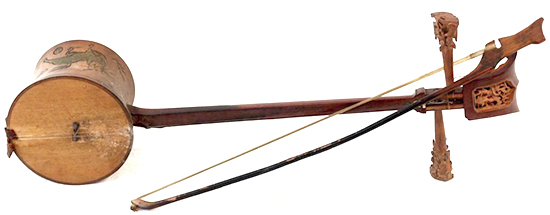
Morin Khuur / Horsehead fiddle
The morin khuur is a two-string stick-fiddle from Mongolia. It is also known as matoqin in Inner Mongolia, and ikili in the Altai Republic. The instrument usually has a carved horsehead scroll. Two pegs are inserted from the sides of the long neck which at the bottom continues through the body. The strings are traditionally horsehair: 130 strands for the male string and 105 for the female string. Contemporary instruments use nylon strings, and sometimes silk strings in Inner Mongolia (as shown). The resonator is trapezoidal and sometimes can be thinner at the top in both width and depth. Traditionally the morin khuur had a goat, camel or sheep skin top, but contemporary instruments use wooden tops and backs. The instrument shown has a skin top and back and a movable bridge. The strings are fretted with the top of the fingernails, which is quite painful when starting to learn the instrument. Held like a cello between the knees, the morin khuur has a rich tone and a wide pitch range. A good player can imitate the sounds of a young pony, stimulating the mare to produce milk, which is a staple of the Mongolian diet.

Ravanhatta
The ravahatta is a two-string stick-fiddle from Northwest India used by religious singers called Bhopa to accompany epic tales of Pabuji, a fourteenth century hero. It has a wooden body and a small coconut resonator covered in skin. There is one melody string made from horsehair, a single metal drone string, and a number of metal sympathetic strings. The bow has a number of small bells attached to provide rhythmic accompaniment.

Rebab - Java
This rebab is an Indonesian two metal string spike-fiddle used in the gamelan orchestra on the island of Java. It has a triangular body covered by buffalo intestine or bladder. The neck is very long and thin, as are the tuning pegs. The instrument is usually placed on the floor in front of the seated musician and is played with a loose horsehair bow. Rather than angle the bow to reach the other string, the instrument is turned slightly so the string comes to the bow. The rebab usually plays a melodic line that is interwoven with the gamelan ensemble, suling flute, or lead singer. It is not a loud instrument and the tone is often quite unsteady, yet it adds a very distinctive sound to the music. The rebab is also used in contemporary scores for gamelan in the West and sometimes combined with non-Indonesian instruments.
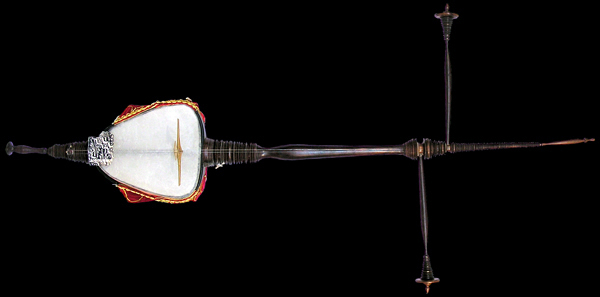
Rebab - Malaysia
The Malaysian rebab is a three-string spike-fiddle from the Kelantan region of Malaysia, used in Mak Yong dance drama, and the Main Puteri trance healing rituals, which is seldom performed today. It is identified by the elaborately carved head. The tuning pegs are inserted from the side of the neck, which travels down through the wooden resonator to end in a spike. The has a goatskin top, and the back is usually draped in cloth. The bridge is movable. The instrument is rotated for the strings to touch the bow. The sound of this rebab is quite haunting.

Rebaba
The rebaba is an Egyptian two-string spike-fiddle used to accompany singing. There are numerous spike and stick fiddles in the Arabic world, and these instruments have a long history. This version has either a coconut or wooden resonator with a goat skin top, two horse or camel hair strings, and pegs that insert from either side of the head. There is a large spike at the end of the resonator to rest the instrument on the ground while playing. The instrument is turned from side to side, rather than the bow moved to bow each string. These are very sturdy instruments that are not very susceptible to weather changes and are good for traveling.

Sarinda - Nepal
The Nepalese sarinda is four-string bowed waisted-rebab used to accompany singing. The body is carved from a single piece of wood, with a skin top only below the waist, leaving the upper portion open. The sarinda is often played with a belt around the waists ot the musician and sarinda, allowing the musician to walk with the instrument. The strings are often played in pairs and the bridge will only have two notches for the two pairs of strings. The bridge is movable and often rest one foot on the edge of the wooden body. Tourist versions of the sarinda are usually quite small yet finely carved, whereas those actively played are often quite roughly hewn.
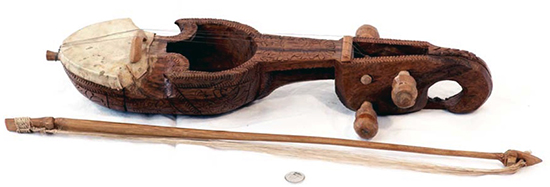
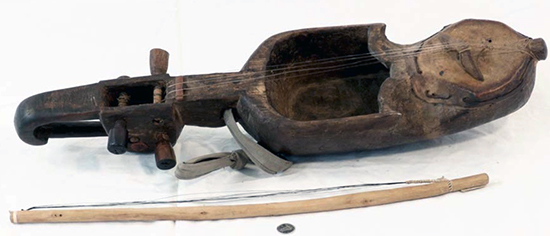
Saw Duang
The saw duang is a two-string spike-fiddle from Thailand, sometimes called a saw i. The resonator is made from bamboo, hardwood or ivory, and is covered in python, goat or calfskin. The neck travels through the resonator has two pegs inserted from the rear. This is a small high-pitched instrument with two metal strings that go over a movable bridge. The bow hairs go between the strings and are attached to the bow stick with a small spike, to allow for easy removal. It is used in court music and in small ensembles. Court instruments are usually very ornate, made with ivory and semi-precious stones.

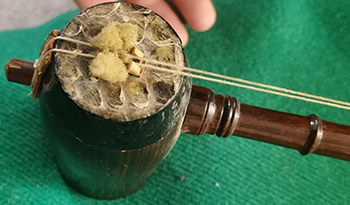
Sihu
The sihu is two-string stick-fiddle from Mongolia, and Inner Mongolia, in China. Shown is a version from Inner Mongolia. The sihu has a wooden resonator covered with skin, in this instance with python skin. The movable bridge in this instance is carved from bone in the shape of two liondogs, and the strings go through the bridge rather than over it. The resonator is pierced by the neck, and the neck has four pegs inserted from the back. The bow strings are split in two, with half going between string one and two, and the other half between strings three and four. Strings one and three are tuned to the tonic, and strings two and four to the fifth. Thus, the instrument sounds like two stick-fiddles playing in unison. Fretting the four strings takes more pressure than a normal stick fiddle. The distance between the neck and strings is quite large, so big hands or long fingers are necessary to play it, and it is usually played by men. Sihu are used in ensemble music and to accompany singing. The Mongolian versions have become quite popular again, as they are often used in throat singing ensembles from Mongolia and Tuva.

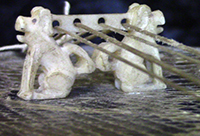
Suranai
This two-string spike-fiddle is reportedly from Kalimantan, Indonesia, although it might also be from the Philippines. The resonator is a coconut shell pierced by a structure made from a number of pieces of bone. The thick skin has a carved movable bridge and the metal strings run to two elaborately carved pegs on either side of the neck. This may be a tourist instrument.
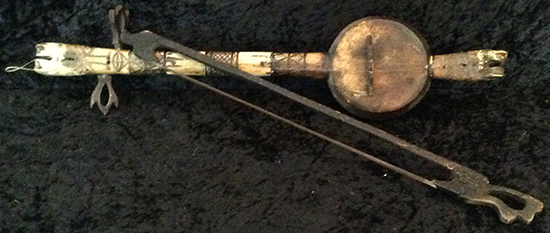
Suranai - Sarawak
Collected in Sarawak Malaysia, and labelled as suranai, this is a one-string spike-fiddle found in Iban communities. It has a partially closed-back bamboo resonator that is covered by skin with a bit of fur added around the edge. The peg enters the neck from the rear (rotated in the picture), and the string is sisal or rattan. The movable bridge was a simple stick. The bow string is also sisal or rattan and friction is created by wetting the bow string. Used to accompany the singing of epic and entertainment songs. 
Xuhu
The xuhu is a two-string stick-fiddle from Fujian Province in southern China. It is used in a regional form called “Ten Sounds”, that can include other types of Chinese huqin (fiddles). The xuhu was a cylindrical wooden resonator, open at the back and with a pythonskin top. The neck is inserted through the resonator, and at the top has carved scroll head, and two carved pegs inserted from the back. The bow is separate from the strings. The bridge is movable, and the strings are metal. This is a smaller instrument about 40 cm long (16 inches), so it has a higher tone. See Laohu.

